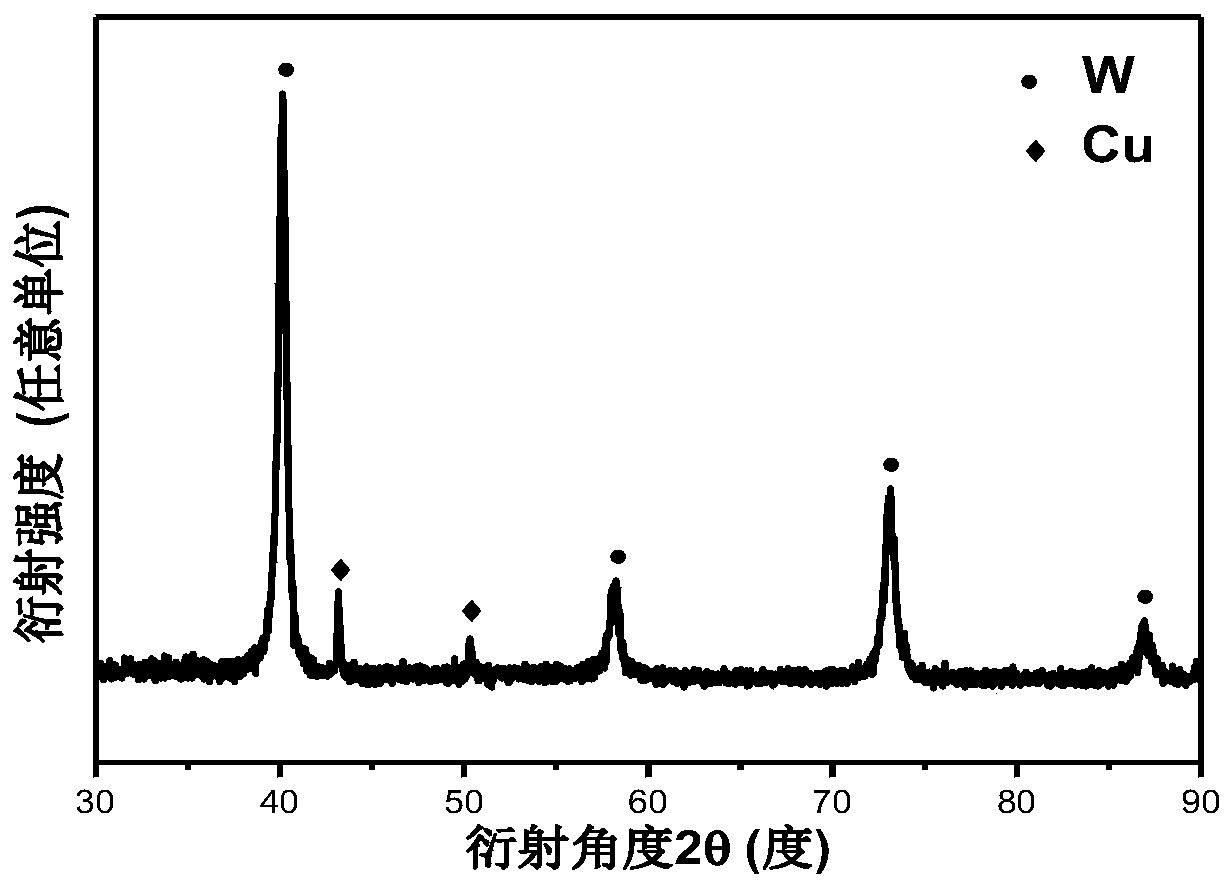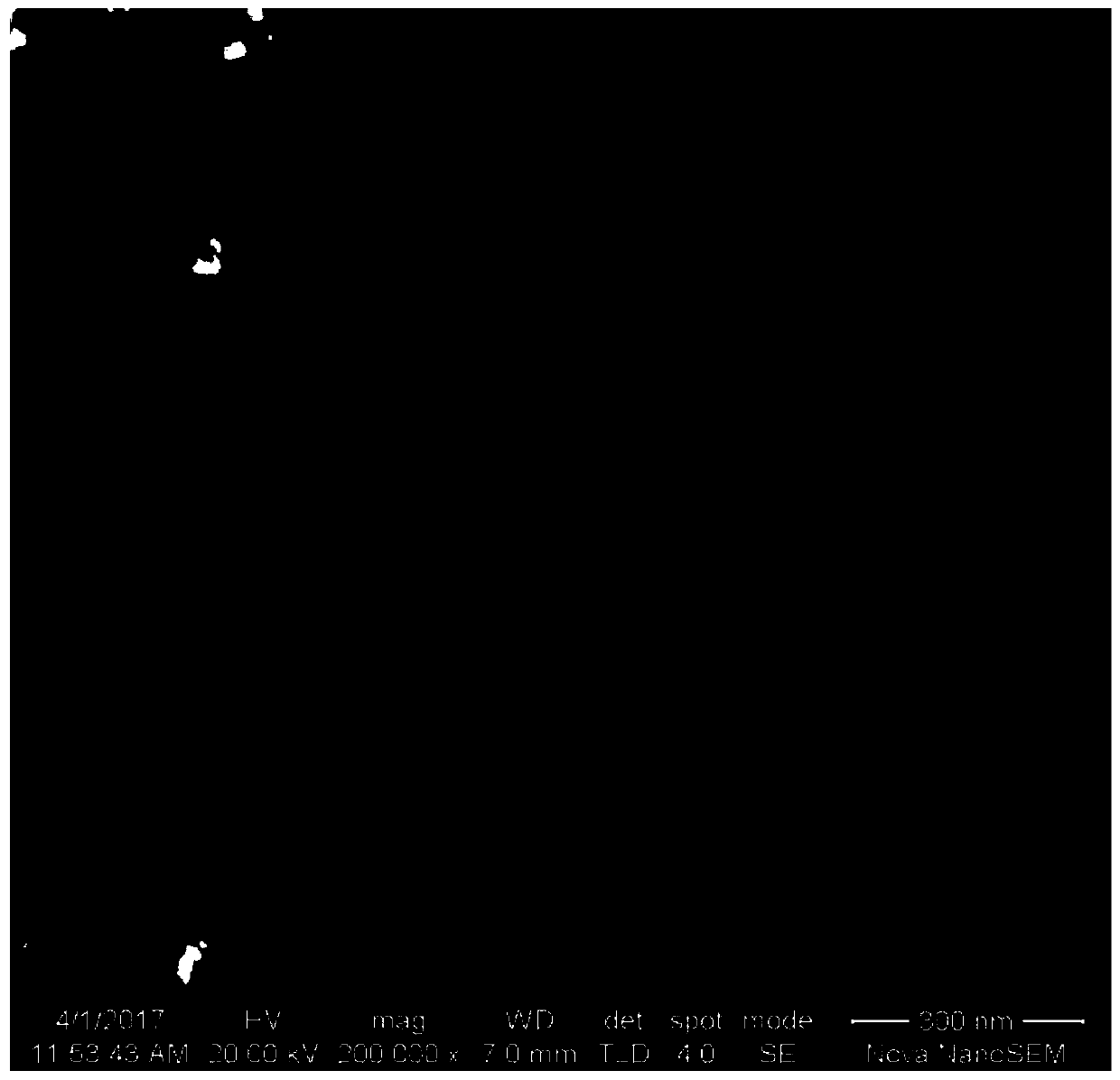A low-temperature preparation method of pure nano w-cu composite powder
A composite powder, pure technology, applied in nanotechnology, metal processing equipment, transportation and packaging, etc., can solve the problems of decreased electrical and thermal conductivity of alloys, low yield of nanoparticles, increased impurity content, etc., to achieve lower synthesis temperature, method Simple and easy to operate, the effect of uniform powder particle size distribution
- Summary
- Abstract
- Description
- Claims
- Application Information
AI Technical Summary
Problems solved by technology
Method used
Image
Examples
Embodiment 1
[0022] Using micron-sized tungsten powder and nano-sized aluminum powder as raw materials, the molar ratio of aluminum: tungsten is 3:1, and the mass ratio of grinding balls to powder is 22:1. Put the grinding balls and powder in a vacuum glove box Put it into a ball mill tank for ball milling, the speed is 400r / min, the ball milling time is 25h, and the powder is scraped every 5h to avoid cold welding to obtain tungsten-aluminum composite powder. The obtained tungsten-aluminum composite powder was corroded by adding NaOH solution with a concentration of 1mol / L for 15 hours, and suction filtered. During the process, ethanol and deionized water were added to clean the powder, and then dried in a vacuum oven at 60°C for 1 hour to obtain pure Nanoporous tungsten powder, its phase is as figure 1 shown. Add the obtained porous tungsten powder into the ethanol solution of copper chloride with a concentration of 0.2g / mL, stir to make the copper chloride solution enter the pores of p...
Embodiment 2
[0024] Using micron-sized tungsten powder and nano-sized aluminum powder as raw materials, according to the molar ratio of aluminum: tungsten is 4:1, the mass ratio of grinding balls to powder is 20:1, put the grinding balls and powder in a vacuum glove box Put it into a ball mill tank for ball milling, the speed is 500r / min, the ball milling time is 20h, and the powder is scraped every 5h to avoid cold welding to obtain tungsten-aluminum composite powder. The obtained tungsten-aluminum composite powder was corroded by adding NaOH solution with a concentration of 1mol / L for 20 hours, and suction filtered. During the process, ethanol and deionized water were added to clean the powder, and then dried in a vacuum oven at 70°C for 1 hour to obtain pure The nanoporous tungsten powder, its microstructure is as follows image 3 shown. Add the obtained porous tungsten powder into the ethanol solution of copper chloride with a concentration of 0.2g / mL, stir to make the copper chloride...
Embodiment 3
[0026] Using micron-sized tungsten powder and nano-sized aluminum powder as raw materials, according to the molar ratio of aluminum: tungsten is 5:1, the mass ratio of grinding balls to powder is 25:1, put the grinding balls and powder in a vacuum glove box Put it into a ball mill tank for ball milling, the speed is 600r / min, the ball milling time is 30h, and the powder is scraped every 5h to avoid cold welding to obtain tungsten-aluminum composite powder. The obtained tungsten-aluminum composite powder was corroded for 25 hours by adding NaOH solution with a concentration of 1mol / L, and suction filtered. During the process, ethanol and deionized water were added to clean the powder, and then dried in a vacuum oven at 50°C for 2 hours to obtain pure Nanoporous tungsten powder, its TEM morphology is as follows Figure 5shown. Add the obtained porous tungsten powder into the ethanol solution of copper chloride with a concentration of 0.2g / mL, stir, so that the copper chloride s...
PUM
| Property | Measurement | Unit |
|---|---|---|
| concentration | aaaaa | aaaaa |
| particle size | aaaaa | aaaaa |
| size | aaaaa | aaaaa |
Abstract
Description
Claims
Application Information
 Login to View More
Login to View More - R&D
- Intellectual Property
- Life Sciences
- Materials
- Tech Scout
- Unparalleled Data Quality
- Higher Quality Content
- 60% Fewer Hallucinations
Browse by: Latest US Patents, China's latest patents, Technical Efficacy Thesaurus, Application Domain, Technology Topic, Popular Technical Reports.
© 2025 PatSnap. All rights reserved.Legal|Privacy policy|Modern Slavery Act Transparency Statement|Sitemap|About US| Contact US: help@patsnap.com



